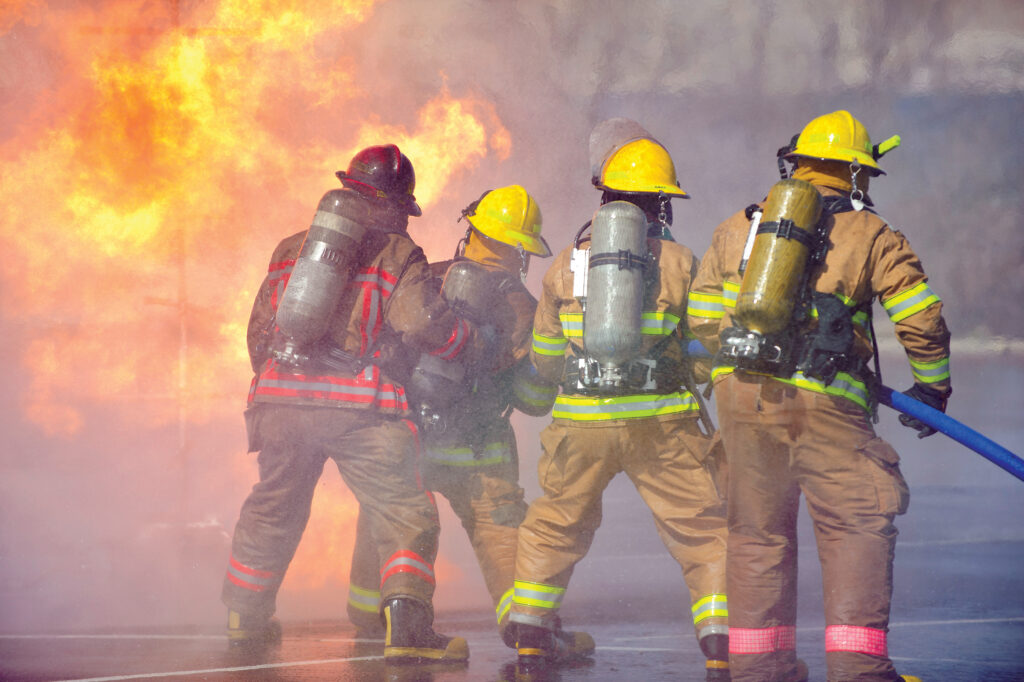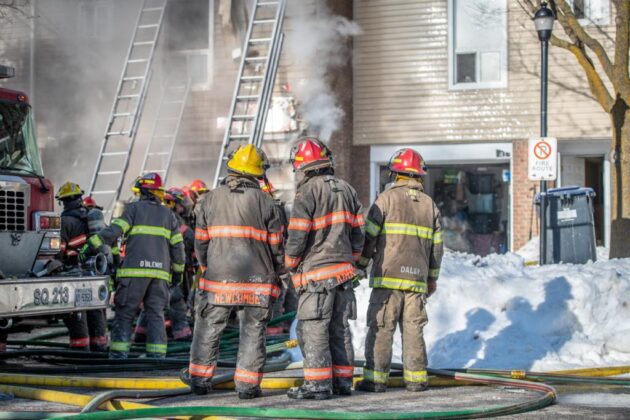
Preserving life on the fireground: The main goal for every call
By Jared Newcombe
Features Equipment Fire Ground Training canadian firefighter firefighter training training wildfire Photo credit: Catonphoto / Adobe Stock
Photo credit: Catonphoto / Adobe Stock Advancing a hose line to an interior position supports all fire ground objectives, leading to the achievement of our overarching goals. The nozzle is the tip of that spear when moving beyond the front door, supported by a team moving as a singular entity and addressing the emerging challenges affecting the completion of the assigned objective.
If a fire begins to overpower the extinguishing capabilities of the chosen handline and requires your team to withdraw or reposition, what’s your strategy?
We have been taught to fight fire, not to retreat, so when I was asked this question back in 2019, my answer was simple: we’d peel back as we continued fighting the fire.
Hose advancement drills
We know that the fire control efforts of the first handline save more lives at a structure fire than any other firefighting action.1 Conducting hose advancement drills between fires is part of our routine for these simple reasons:
- Hose advancement, when combined with door control, limits air flow to a ventilation-limited fire and reduces the heat release rate.2
- Finding synchronization of movement and tempo amongst the team on the hose line is imperative. When you consider the varied sizes of firefighters, levels of athleticism, experience and injuries, the movement of the hose line may be fluid, or not, on any given day. Drilling leads to mindfulness and equips them with the knowledge that allows the advancing team to fine tune their movements, complementing each other on the line, resulting in a more methodical and effective execution of the task at hand.
Implementing the drill is easy; flake out a 1 ¾ inch hose line on the floor and charge it. The nozzle or pipe person leads the charge—demonstrating the various approaches within their arsenal—advancing the hose line, and seamlessly transitioning between “hit and move” and “flow and move” techniques. This skillfully executed advance is contagious, and we realize that we are not finished products, but a work in progress. We have a lot more to learn.
Each person takes a turn clamp sliding forward to the halfway point, then transitioning the hose from under the knee to the hip, resuming the advance, flowing, whipping, sweeping skillfully – yet aggressively – while proceeding to the intended target. Once we are properly warmed up, ready and hungry to do more, the stage is set for us to find our synchronicity on the line as a team.
Incorporating the controlled exit or peel back is easy to do, but far from routine. When we decided to test this approach as a team, we realized we had overestimated our abilities, falling short of what we believed we could accomplish (Dunning Kruger Effect3). The difficulties stemmed from the unsynchronized movement of the team on the line and an ensuing tug-o-war between us. A combination of the varied approaches we applied included standing up, walking back, some crawled on all fours, and some inched their way backward on their knees. The fluidity we were accustomed to when moving the nozzle forward wasn’t there, and we didn’t have a combat-ready approach. This was a tough pill to swallow, but the fuel to finding a solution.
The ability to move backwards as efficiently as we move forward aids in both civilian and firefighter life safety.
Testing out different methods
Our team looked at the approaches we’d been using to move the nozzle forward and how we could apply them to an exit strategy. We identified the clamp slide used to hit and move was the best approach to achieving a controlled exit while remaining engaged.
How do you incorporate a clamp into this controlled exit strategy? It starts with communicating the need to peel back, reposition or exit, and the team adjusts their positioning to execute the tactic of moving backwards. The nozzleman places the line under the knee towards the ankle and settles into a clamp slide position while, simultaneously, the firefighters reverse their pulling positions towards the entry point (pushing leg cocked and ready to engage with each order), and they communicate that they’re ready to move. In preparation for the line to move backwards, the nozzle person lightens their pinning leg using the hand on the same side of their body. Their weight shifts slightly forward to reduce friction against the floor, yet stay cognisant not to force the line backwards as they call, “ready move”. The firefighters on the line engage their cocked legs and push in unison, moving approximately three feet. The team on the line repeats the process to the nozzleman’s cadence and they slide gracefully into positions that serve a greater tactical purpose.
As your team finds their synchronicity on the line, you may want to incorporate multiple pinch points, flowing water as you reposition while being able to address fire that may get behind you. The ability to move backwards as efficiently as we move forward aids in all life safety.
Case study
In Dec. 2021, I was given a new station assignment with a group of firefighters that had never worked together before, which left many unanswered questions about how we’d work as a team. We used the hose management and advancement drills to break the ice and begin team building. We quickly found our varied approaches morphing and aligning with what we all considered best practice, resulting in a more cohesive and synchronized movement. Using everyone’s input on how to accomplish our mission, we established expectations and trust between us.

Photo credit: Kyle Taylor
During and after our training, many conversations ensued that included ideas like: using a thermal imaging camera in cooperation with advancement, reading the door, feeding hose and other old school techniques. This set the stage for how we conducted all our training – hands on.
On Jan. 20, 2022, one of my firefighters – who is an acting captain – took my role as the officer, and I took his position on the rig. On this day, our mettle was to be tested at a townhouse fire. My level of trust in said acting captain and the team was high, but there were still some unanswered questions about how we would fair in battle as a team.
We were returning from a motor vehicle collision when we received the notification of a townhouse fire. On approach, there was a great amount of smoke filling the sky, narrowing to the visible fire blowtorching through the backside of the fire unit. Fire inside, outside and extending up vinyl clad to the third story attic. As our truck took a position between cars randomly positioned on scene to watch the unfolding events, smoke and flames were seen extending beyond the front door; heavy black, voluminous smoke was seen pushing from the second-floor window, and we saw slightly less on the third floor. The front door had been kicked down by someone prior to our arrival, which left us unable to control it and ultimately resulted in an irrepressible flow of oxygen feeding the fire. We had a short stretch of approximately 20 feet to the front door. Working through the deep snow, we positioned a 1 ¾ inch hose line quickly.
We needed to get control over the main body of fire on the ground and its extension to the second floor as soon as possible. As the line was charging, the acting captain shared the thermal camera with the team, orienting the location of the stairs and layout as rehearsed. The bale opened and the reach of the stream was put to work. First, we would hit the stairs, followed by the hallway, which would lead us into the main fire on the ground floor. Whipping and sweeping, we advanced, knocking the fire down as conditions changed favourably. We were gaining the tactical advantage over the fire. We moved the line backwards to the entry and up the stairs to the second floor where we began extinguishing the fire that had extended up and through to the kitchen. This team, who had just recently come together, was cohesive in the way they moved through the ground floor, through to the second floor, and was confident in their decisions.
Just as we gained the advantage on the second floor and readied to clear the room, something changed on the ground floor. The acting captain noticed that the fire on the lower level had redeveloped and was chasing the flow path to our location, leaving us in a vulnerable position. We would need to reposition and reengage the fire on the ground floor. We moved backwards with ease and forward again, eliminating any potential of redevelopment. Simultaneous rescue efforts were underway on the second and third floors, utilizing windows and stairs secured by the first handline.
Before the fire, there were unanswered questions about how we would fair in battle as a team. That question was put to bed as the team remained disciplined and mindful of expectations. The training in the station prior to this incident allowed us to build a cohesive team, able to move forward and backwards seamlessly and in sync with each other, preserving life on the fire ground.
References
- Fredericks, Andrew A. “Stretching and Advancing Handlines, Part 1.” Fire Engineering. 1997. https://www.fireengineering.com/firefighting/stretching-and-advancing-handlines-part-1/#gref.
- Hartin, Ed. “Influence of Ventilation in Residential Structures: Tactical Implications Part 2.” CFBT-US LLC. https://cfbt-us.com/wordpress/?p=1534.
- Dunning, David. “Chapter five – The Dunning-Kruger Effect: On Being Ignorant of One’s Own Ignorance.” Advances in Experimental Social Psychology vol. 44, 2011, pages 247-296.
Author note: Special thanks to Chris O’blenis, Craig Daley, James Foster, Jen Gould, James Kirk, Paul Winkley, Kyle Taylor, 213 B and C/D shift for their work in the training initiative.
Interested in learning more about how this works? Check out training videos here.
Jared Newcombe is a captain and a 29-year veteran of the Brampton Fire and Emergency Services in Ontario.
Print this page